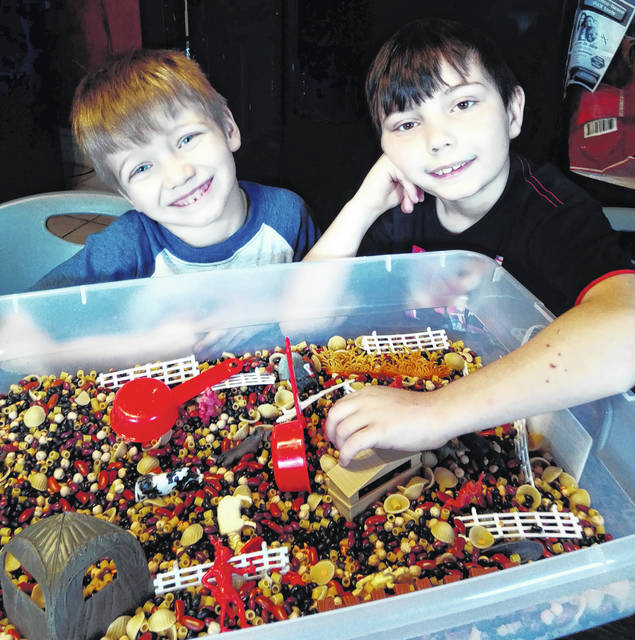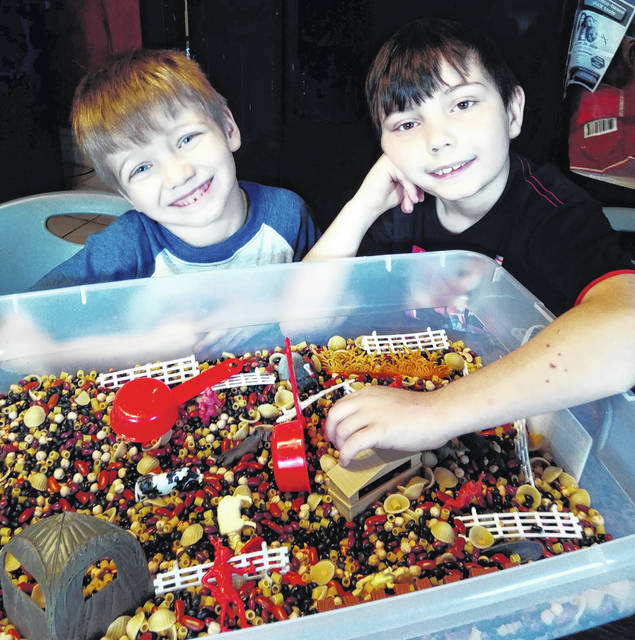

In the local Matthews family household, sensory bins are one tool being used to keep the kids entertained and busy while providing stimulation as schools are currently closed during the COVID-19 pandemic.
Sensory bins are essentially containers filled with different items and materials that allow kids to use multiple senses such as sight, smell, touch, auditory and occasionally, taste. They can be purchased and also made at home using everyday objects.
According to Monica Matthews, the “sensory bins have been a lifesaver for some ‘quiet’ time instead of TV and video games” for her two younger sons, Draven and Zaden Sullivan. Draven is 8-years-old, while Zaden is 5-years-old.
One of their bins contains cedar mulch and marbles. Recently, the children took time to locate all the marbles hidden in the mulch. Other bins they have include either rice, oats or beans.
According to Monica, with the boys home, they keep her on her toes as she needs to keep them busy to avoid fighting.
“They are brothers so they are sick of each other,” she explained. “They keep asking, ‘When does school start back up?’ We have had a lot of talk about the virus. I am trying my best to make this time fun and not scary.”
Another activity they have recently done was to make salt dough star-fish decorations for the bedroom of Monica’s first grandchild. Her daughter is currently 15 weeks pregnant and the nursery has an ocean theme.
Other than sensory bins and homeschooling efforts, Monica continues to work as a janitor on third shift at Walmart DC while her husband, Mason Matthews, continues to work as a diesel mechanic on first shift at Travel Center of America, a truck stop commonly known as TA.
“So, he has to be there to make sure the trucks stay on the roads,” she explained. “And I clean and sanitize the Walmart DC facility to try to keep them healthy, so they can get those essential items on the trucks.”
In trying to keep her kids in a routine, she has developed her own during this time, which includes getting home around 5 a.m. from work, taking care of herself and getting to sleep as quickly as she can. Then she tries to sleep until her alarm goes off at 10 a.m., unless the boys wake up before then, in efforts to keep them from “roaming alone.”
“I have messed up their nighttime bedtime a bit, though I tried not to,” she explained. “For them to let me sleep ‘til at least 10, I have to let them stay up later with my husband. That is one bad thing about this — it’s very hard to keep the school schedule.”
Even though the school schedule is off, she expressed that they are trying to keep a regular routine at home so the kids “feel safe and not feel like things are out of control.”
“My son (Branson Warner) also works at TA. My daughter (Savannah Warner), who is 15 weeks pregnant, just made the decision to stay home and basically lose her job (recently), because she is worried about the baby’s safety. She worked with me as a janitor as well. It broke her heart to have to make such a hard decision, because she loves her job,” explained Monica. “Nowadays, the sacrifices we have to make are so hard but something we have to make.”
One thing Monica expressed they are thankful for is the recent nice weather that has allowed “recess” outside. Activities while outside have included raking leaves and picking up trash.
Another thing Monica expressed thankfulness for was the Miami Trace Local Schools’ lunch program that has been providing meals to students.
“The school lunch program is awesome,” she explained. “For a night shift parent, it helps so much for them to have ready-made food to grab.”
Those who wish to try sensory bins like the Matthews household can easily create them by using items around the house. There are several ideas available online. One website with helpful descriptions on making sensory bins is www.//happyhooligans.ca/sensory-bins/.
The website explains that “a great sensory bin is like a world of discovery in a box. It encourages open-ended play and provides endless opportunities for experimenting and learning.”
The website further explains that a sensory bin can encourage critical thinking by letting a child problem-solve, make observations and form conclusions as they scoop, pour and measure material. The bins can also foster imagination as a child may pretend to be a baker or a scientist with the instruments that are provided, and strengthen fine-motor skills as a child manipulates tweezers or tongs and other small items in the bin, as well as build language skills and introduce new vocabulary when new and unfamiliar items are used in the bin.
For the “bin,” items that can be used include bowls, pans, large hats, sand buckets, cardboard boxes, foil pans, totes, etc. Keep in mind that the size of the bin needed may be larger depending on the number of children that will be using it.
Once the “bin” is chosen, picking a theme for the bin can help determine what items should go into it. The theme can be based off something the kids are passionate about, such as dinosaurs, the ocean, cars, Legos, animals, construction, etc.
After the bin and theme have been chosen, a material, the “base,” can be chosen. This is the main material to go inside the bin for kids to sift through. The options for this base are various, but safety is important to keep in mind as kids will be sorting through the bin and younger kids may attempt to eat the material.
Some ideas for materials to use as a base include flour, water, potting soil, dry pasta, dry rice, sand, bird seed, shaving cream, small or glass rocks, etc. The website suggests coffee grounds for a construction (digging) theme.
Next is choosing what items to place in the bin. These items, once again, can be numerous and can be everyday items around the house, especially toys. Keep in mind what base is being used to keep the items from being ruined.
Some ideas for items to go in the bin include marbles, sticks, rocks, flower petals, dry and uncooked beans, and various toys. Craft items can also be added for more texture such as cotton balls, pom poms, foam shapes, etc.
Instruments for the bins can allow kids to get creative in their play. Some instrument ideas are small (but safe) gardening tools, sand shovels, spoons, tweezers, scoops (either toys or scoops from the kitchen), magnifying glasses, small bowls, etc.
All of the above instructions can be brought together to form creative and fun bins tailored to individual children.
For example, to make an excavation site in a bin, a shallow container (such as a long plastic bowl) could be used, the material could be potting soil, sand, rice, flour or coffee grounds. The items could be buried toy dinosaurs, marbles, rocks and other natural objects such as broken up sticks. Tools for this bin could include an old (but cleaned) make-up brush, q-tips, tweezers, a small spoon, a bucket to hold the “fossils,” etc.
Both older and younger kids could help search for items and create these sensory boxes, which could foster several different types of lessons while keeping them busy and productive. In order to keep everything as sanitary as possible, objects can be sanitized between use and kids can practice proper hand-hygiene both before and after play.
“You can keep kiddos busy with silly, little things that you have around the house,” explained Monica. “I know there has to be a lot of us moms working essential needs that would love to have a ‘staycation,’ but we take what we have and are thankful.”
Have you or your kids been keeping busy? Feel free to reach out to the Record-Herald if you want to share ideas with the community. Reach Jennifer Woods at 740-313-0355 or by email at [email protected].


